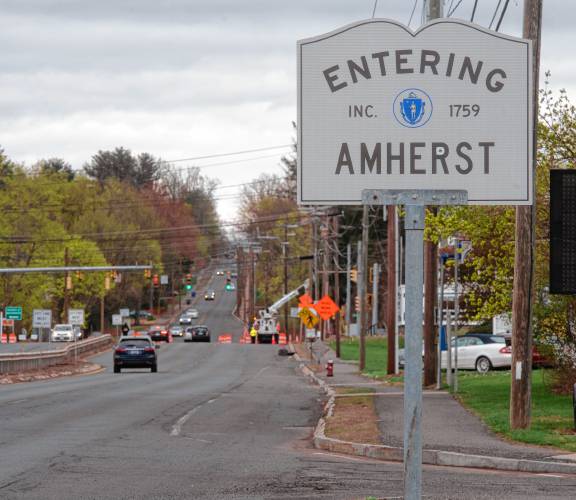Bridget Miller: Why walkability is the pathway to a healthy Amherst community

STAFF PHOTO STAFF PHOTO
| Published: 04-18-2024 5:26 PM |
Picture a quiet rural town where the charm of winding roads and open spaces should invite pleasant walks and friendly encounters. Yet, instead of a stroll, residents navigate treacherous paths and dodge traffic on roads devoid of sidewalks or safe crossings.
This isn’t just an inconvenience; it’s a silent threat to the well-being of our community and the areas surrounding Amherst.
The Boston Medical Center defines walkability as the “environmental characteristics that promote health by encouraging the use of sustainable modes of transportation to access social and personal resources.” There are many components to an area’s walkability, such as pedestrian-friendly facilities like sidewalks, parks/open spaces, and traffic-calming infrastructure like crosswalks and speed bumps. Though pedestrian volumes are lower than in urban communities, many rural areas don’t even have paved shoulders along roads, forcing pedestrians to walk in the street, according to the Federal Highway Administration.
This is especially true in Amherst, as paths and sidewalks are far and few between on several main roads including North Pleasant Street, Eastman Lane, East Pleasant Street, and Pine Street. Residents of these specific streets, as well as many other areas in the community, are most affected by the town’s lack of walkability, especially those who may not have a car or use public transportation like the PVTA. The Amherst community’s health and safety will suffer without adequate and equitable infrastructure targeting improved walkability.
National Institute of Health statistics show that the likelihood of a pedestrian crash per mile along roads with no sidewalk is three times greater than the likelihood of being hit on a street with a sidewalk, highlighting the direct effects on resident safety regardless of health status or lifestyle.
Additionally, data from Harvard University shows that improving access to walking areas and overall community connectivity helps reduce high blood pressure and the risk of developing cancer, diabetes, heart disease, arthritis, and depression, showing an even more apparent need for comprehensive walking resources.
When looking to enhance walkability in rural western Massachusetts, a comprehensive plan in place in Le Sueur, Minnesota presents a compelling blueprint for success. Enacted in 2018, this policy mandates the construction of sidewalks in new subdivisions on roads exceeding 500 feet and emphasizes connections between neighborhoods, parks, schools, and other destinations. Furthermore, it integrates trails into the community fabric to encourage active living and alternative transportation.
What sets this policy apart is its tangible impact on community life. Resident feedback in 2021 detailed the love and high utilization of the new trails and sidewalks and highlighted its success in meeting the community’s needs. By providing safe and accessible routes for pedestrians and cyclists, this policy promotes equity by offering transportation options beyond cars and accommodating those reliant on walking or biking.
Article continues after...
Yesterday's Most Read Articles
 Pro-Palestinian protesters set up encampment at UMass flagship, joining growing national movement
Pro-Palestinian protesters set up encampment at UMass flagship, joining growing national movement
 Island superintendent picked to lead Amherst-Pelham region schools
Island superintendent picked to lead Amherst-Pelham region schools
 Sole over-budget bid could doom Jones Library expansion project
Sole over-budget bid could doom Jones Library expansion project
 State fines Southampton’s ex-water chief for accepting lodging and meals at ski resort, golf outing from vendor
State fines Southampton’s ex-water chief for accepting lodging and meals at ski resort, golf outing from vendor
 Authorities ID victim in Greenfield slaying
Authorities ID victim in Greenfield slaying
 2024 Gazette Boys Basketball Player of the Year: Marcielo Aquino, Amherst
2024 Gazette Boys Basketball Player of the Year: Marcielo Aquino, Amherst
The Le Sueur plan addresses not only safety but also community access and health. The infrastructure facilitates external connectivity and incorporates open spaces within neighborhoods, fostering a sense of belonging and promoting mental and physical well-being. This holistic approach reflects an understanding of the interconnectedness between environmental characteristics/infrastructure, personal health, and community ties.
While cost considerations are necessary, Le Sueur’s success in securing funding through federal grants suggests the feasibility of similar opportunities in Amherst and rural western Massachusetts.
Le Sueur’s successful track record, coupled with the focus of its walkability plan on safety, equity, and community access, showcases its clear benefits and the need to replicate it in Amherst. It’s time to re-create this model and pave the way for a safer and more accessible future for all Amherst residents.
Bridget Miller lives in Amherst.

 Columnist J.M. Sorrell: Days to remember
Columnist J.M. Sorrell: Days to remember Guest columnist Owen Mitz: A hybrid suggestion for King Street
Guest columnist Owen Mitz: A hybrid suggestion for King Street Paul Craig: Gun control debate a fractured discourse
Paul Craig: Gun control debate a fractured discourse Bernie Sadoski: Blake Gilmore is committed to his community
Bernie Sadoski: Blake Gilmore is committed to his community
